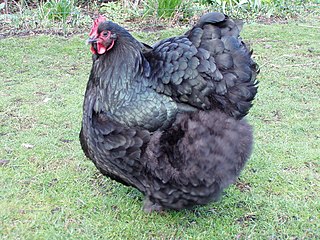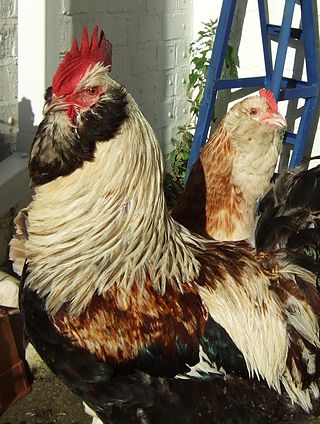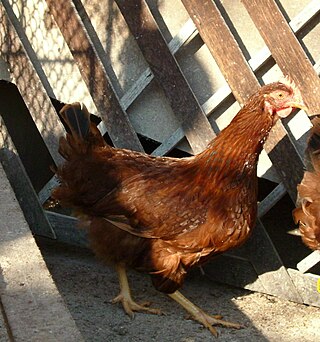Related Research Articles

The Leghorn, Italian: Livorno or Livornese, is a breed of chicken originating in Tuscany, in central Italy. Birds were first exported to North America in 1828 from the Tuscan port city of Livorno, on the western coast of Italy. They were initially called "Italians", but by 1865 the breed was known as "Leghorn", the traditional anglicisation of "Livorno". The breed was introduced to Britain from the United States in 1870. White Leghorns are commonly used as layer chickens in many countries of the world. Other Leghorn varieties are less common.

The Orpington is a British breed of chicken. It was bred in the late nineteenth century by William Cook of Orpington, Kent, in south-east England. It was intended to be a dual-purpose breed, to be reared both for eggs and for meat, but soon became exclusively a show bird.

The ISA Brown is a crossbreed of chicken, with sex-linked coloration. It is thought to have been the result of a complex series of crosses including but not limited to Rhode Island Reds and Rhode Island Whites, and contains genes from a wide range of breeds, the list of which is a closely guarded secret. It is known for its high egg production of approximately 300 eggs per hen in the first year of laying.
The Croad Langshan is an old, heavy, soft-feathered chicken breed which probably originated in China.

Sex-links are crossbred chickens whose color at hatching is differentiated by sex, thus making chick sexing an easier process. Sex-links come in several varieties. As hybrids of laying or dual-purpose breeds infused with extra vigor via heterosis, sex-links can be extremely good egg-layers which often produce 300 eggs a year or more depending on the quality of care and feed. The color of their eggs vary according to the mix of breeds, and blue-green eggs are possible.
Hollands are a fairly rare breed of large chickens that are dual purpose and originate from America. They are hard to tell from Plymouth rocks and Dominiques, but can be recognized as the Plymouth Rock has colored feet and the Dominique has a rose comb.

The New Hampshire Red or New Hampshire is an American breed of chicken. It was developed in the early twentieth century in the state of New Hampshire by selective breeding of Rhode Island Red stock; no other breed was involved. It is fast-growing, early-maturing, quick-feathering, and yields a meaty carcass. Mature birds are a light or medium red in color; they may fade in sunlight.

The Faverolles is a French breed of chicken. The breed was developed in the 1860s in north-central France, in the vicinity of the villages of Houdan and Faverolles. The breed was given the name of the latter village and the singular is thus also Faverolles, not Faverolle. The final "s" is silent in French.
The Iowa Blue is a breed of chicken that originated near Decorah, Iowa, in the early twentieth century. Despite its name, the breed is not actually blue according to poultry standards. It is an exceedingly rare fowl, and is not recognized for showing by the American Poultry Association. They are a dual-purpose breed laying brown eggs and known to be good foragers.
The Ixworth is an English breed of white domestic chicken. It is named for the village of Ixworth in Suffolk, where it was created in 1932. It was bred as fast-growing high-quality meat breed with reasonable laying abilities.
Keeping chickens as pets, for eggs, meat, or for eating pests is popular in urban and suburban areas. Some people sell the eggs for side income.
Ayam Kedu is a breed of chicken, originating in Indonesia. It is one of the ancestors of Ayam Cemani

The Stara Zagora Red is a Bulgarian breed of domestic chicken from the oblast of Stara Zagora, in the central-southern part of the country. In the mid-20th century local chickens of Stara Zagora were crossed with Rhode Island Red chickens.
The Ermellinata di Rovigo is a modern Italian breed of dual-purpose chicken. It originates in the city of Rovigo in the Veneto region of north-eastern Italy, from which it takes its name. It was created between 1959 and 1965, principally from Sussex and Rhode Island Red parentage.

The Euskal Oiloa, Spanish: Gallina Vasca, is a breed of domestic chicken from the autonomous community of the Basque Country in north-eastern Spain and south-western France. It is the traditional rural chicken of the area, a rustic dual-purpose breed of Atlantic type, and differs from Mediterranean Spanish breeds such as the Castellana Negra and the Minorca in several respects: it has yellow legs and feet, red earlobes, and lays brown eggs.

Altsteirer, also known as the Styrian Hen and Chicken, Slovene: Štajerska kokoš or Štajerka, German: Altsteirer Huhn, is an autochthonous breed of domestic chicken originating in Slovenia and Austrian state Styria. The Styrian Hen is known as the only autochthonous (native) chicken breed of Slovenian area, with all other breeds being traditional at most, hence introduced in the past and consequently adapted to country's conditions. The Altsteirer's set of traits suggests the breed may share a common descent with other Mediterranean chicken breeds.
Slovenian Barred Hen is a traditional breed of domestic chicken, originating in Slovenia. This breed was developed on the Biotechnical Faculty of University of Ljubljana some decades ago. Animals of the Slovenian Barred Hen are barred black and white layer hens, used primarily for production of commercial crossbreeds sold under the trademark Prelux.
Slovenian Silver Hen is a traditional breed of domestic chicken, originating in Slovenia. The breed, that was developed some centuries ago on the Biotechnical Faculty of University of Ljubljana, is characterised by typical white coloured layer hens, used primarily for production of commercial crossbreeds sold under the trademark Prelux.
Prelux are commercial chicken crossbreeds of the Slovenian origin, that are being sold under the eponymous trademark by the Biotechnical Faculty of University of Ljubljana. The name is an abbreviation for the Slovenian phrase prevojski luxuriranci, with a word luxuriranci referring to luxuriance (heterosis) or outbreeding enhancement of hybrid offspring, and adjective prevojski referring to the Slovenian settlement Prevoje, where selective breeding was once performed. This name was given to quality layer hens, that are being obtained by crossbreeding three Slovenian traditional breeds of layer hens; Slovenian Barred, Slovenian Brown and Slovenian Silver Hen. The most known and best-selling layer hens of the trademark Prelux are Prelux-Č, Prelux-G and Prelux-R. A part of the selection is also a meat type chicken (broiler), Prelux-BRO.
Slovene Late-feathered Hen is a traditional breed of domestic chicken, originating in Slovenia. The breed is categorised as a heavy or meat type, and is consequently used for raising broilers. As of year 2013, when two heavy breeds Slovene Early-feathered Hen and Slovenian Fathering Hen were removed from the list, it is the only meat type chicken breed among Slovenian traditional breeds of domestic animals. The Slovene Late-feathered Hen is characterised by animals covered with white plumage and known for slow feathering speed.
References
- ↑ "Shaver Red Sex-Link". Archived from the original on 2010-03-22. Retrieved 2010-01-04.
- ↑ "Henhouse Haven page, Moore Partners, writing, editing, website design". Archived from the original on 2011-07-06. Retrieved 2010-02-02.
- ↑ "Shaver Red Sex-Link". Archived from the original on 2010-03-22. Retrieved 2010-01-04.
- ↑ https://www.cbc.ca/news/canada/ottawa/giant-egg-laid-by-ottawa-hen-1.775106. Archived 2018-05-09 at the Wayback Machine